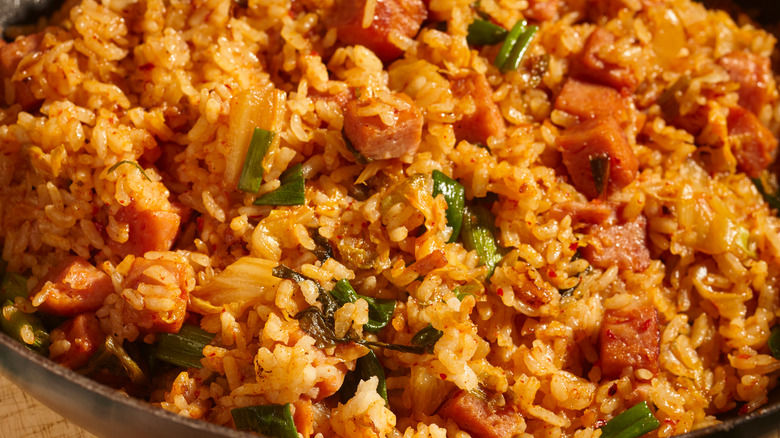Add Spam To Your Fried Rice For A Hawaiian Twist
One of life's enduring mysteries, at least to those with an aversion to mystery meats, is why Spam is so entrenched in Hawaiian cuisine. While Aloha State dining has much more to offer in the way of fresh seafood, tropical fruits, and pit-roasted pig, there's no denying the ubiquity of a certain meat product that was introduced to the islands during WWII. While Hawaiians fix Spam in many different ways, including the famous sushi-style Spam musubi, one simpler dish is the Spam fried rice which can be either a side or a breakfast item.
In its most basic form, Hawaiian-style Spam fried rice consists of little more than rice, eggs, and diced Spam, with perhaps some soy sauce or Maggi seasoning and garlic for flavor. Other, more elaborate, iterations may feature add-ins such as peas, carrots, and onions and additional seasonings in the form of ginger, mirin, rice wine vinegar, or sesame oil. Contrary to clichéd expectations, however, pineapple isn't typically a part of the dish. Still, there's no reason why you couldn't throw it into the mix if you happen to enjoy the flavor. Pineapple, after all, would add some sweetness and tartness to a dish that can be fairly salty from the soy sauce and Spam.
Or go Korean-style with spam and kimchi
Hawaii isn't the only place to embrace the pork product that comes in a blue can as Spam is so popular in Korea that it's often packaged in gift sets for holiday giving. Spam is also a core ingredient in budae jjigae, the stew that was birthed on an American army base (or at least midwifed by the base commissary). Korean cuisine has its own version of Spam fried rice, too. Only here it's paired with the quintessentially Korean ingredient known as kimchi. In fact, so well-known is kimchi fried rice that it's even featured on the Spam website.
Kimchi fried rice with Spam, like its Hawaiian cousin, may be seasoned with soy sauce and garlic, but it is also likely to include Korean seasonings such as gochujang paste or gochugaru flakes and maybe some of the dried seaweed known as gim. The eggs here aren't scrambled into the mixture, either, but are rather fried and plopped on top. Either way you cook them, though, they still make a great partner for good old Spam, something that seems to get way more love outside its native land (or at least the mainland) than it does here in the contiguously-United States.

